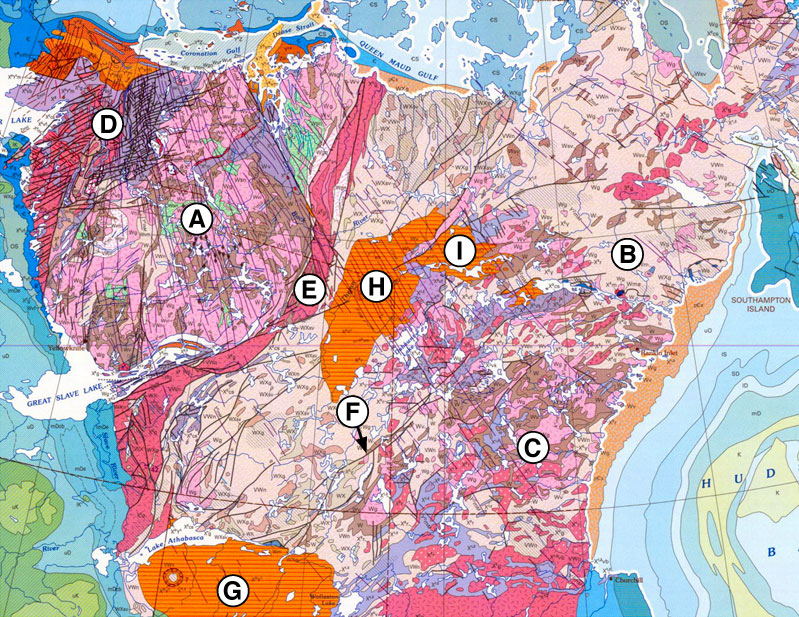Hearne Craton on:
[Wikipedia]
[Google]
[Amazon]

 The Hearne Craton is a
The Hearne Craton is a

 The Hearne Craton is a
The Hearne Craton is a craton
A craton (, , or ; from grc-gre, κράτος "strength") is an old and stable part of the continental lithosphere, which consists of Earth's two topmost layers, the crust and the uppermost mantle. Having often survived cycles of merging an ...
in northern Canada which, together with the Rae Craton
250px, North America cratons and basement rock.
The Rae Craton is an Archean craton located in northern Canada north of the Superior Craton.
Ungava Peninsula
The Ungava Peninsula, situated on the northeast portion of the Canadian Shield, is w ...
, forms the Western Churchill Province. Hearne is one of the six Archaean cratons of the Canadian Shield (the other being Slave, Rae, Wyoming
Wyoming () is a state in the Mountain West subregion of the Western United States. It is bordered by Montana to the north and northwest, South Dakota and Nebraska to the east, Idaho to the west, Utah to the southwest, and Colorado to the s ...
, Superior, Nain) that are bound together by Palaeoproterozoic orogenic belt
An orogenic belt, or orogen, is a zone of Earth's crust affected by orogeny. An orogenic belt develops when a continental plate crumples and is uplifted to form one or more mountain ranges; this involves a series of geological processes collec ...
s. Before being merged these six cratons formed independent microcontinent
Continental crustal fragments, partly synonymous with microcontinents, are pieces of continents that have broken off from main continental masses to form distinct islands that are often several hundred kilometers from their place of origin.
Caus ...
s.
Geological setting
The Hearne Craton is separated from the Rae Craton by the -long Snowbird Tectonic Zone (STZ). During the Neoarchaean and Palaeoproterozoic the STZ played a major role when the Western Churchill Province was first assembled and then reworked. The STZ is a record of Neoarchaean plate tectonics similar in scale to modern orogenic belts. WhenLaurentia
Laurentia or the North American Craton is a large continental craton that forms the ancient geological core of North America. Many times in its past, Laurentia has been a separate continent, as it is now in the form of North America, althoug ...
formed at 2.0–1.7 Ga Hearne and Rae formed a central strip to which the Slave, Superior, Sask, and Wyoming
Wyoming () is a state in the Mountain West subregion of the Western United States. It is bordered by Montana to the north and northwest, South Dakota and Nebraska to the east, Idaho to the west, Utah to the southwest, and Colorado to the s ...
cratons were accreted. This strip is bounded by a series of orogen
An orogenic belt, or orogen, is a zone of Earth's crust affected by orogeny. An orogenic belt develops when a continental plate crumples and is uplifted to form one or more mountain ranges; this involves a series of geological processes collecti ...
s: the 1.92–1.69 Ga Trans-Hudson to the south, the 2.0–1.9 Ga Taltson–Thelon and the 1.97–1.84 Ga Wopmey to the west. Hearne and Rae were extensively reworked during the assembly of Laurentia and overlain by Palaeoproterozoic cover sequences. On Hearne the most extensive such cover sequence is a series of continental and marine deposits known as the Hurwitz Group, a series of north-east-trending belts that cover . A synclinoria infolded with Archaean basement in central Hearne has a fold-train with a wavelength of . In the south-western Hearne continental siliciclastic
Siliciclastic (or ''siliclastic'') rocks are clastic noncarbonate sedimentary rocks that are composed primarily of silicate minerals, such as quartz or clay minerals. Siliciclasic rock types include mudrock, sandstone, and conglomerate
Conglomera ...
rocks known as the Kiyuk Group overlie the Hurwitz Group. Both groups are covered by a thick cover of thrusts and folds.
Manikewan Ocean
The Manikewan Ocean, a palaeocean named by , started to open along the south-east margin of Hearne at 2.075 Ga and had reached a width of after a hundred million years. Intra-oceanic arc collision resulted in the Amisk Collage and theFlin Flon
Flin Flon (pop. 5,185 in 2016 census; 4,982 in Manitoba and 203 in Saskatchewan) is a mining city, located on a correction line on the border of the Canadian provinces of Manitoba and Saskatchewan, with the majority of the city located within M ...
– Glennie Complex around 1.92–1.88 Ga. Today these Palaeoproterzoic structures in the Trans-Hudson Orogen welds the Archaean Hearne and the Superior cratons. As the ocean continued to close, an Andean-style arc pluton known as the Wathaman Batholith formed 1.86–1.85 Ga. The subduction of the Manikewan Ocean stopped when the La Ronge Arc collided with Hearne. The final closure of the ocean around 1.83 Ga, when Hearne, Superior, and Sask cratons merged with the Flin Flon – Glennie Complex, was followed by a period of metamorphism that peaked around 1.82–1.8 Ga. The Manikewan Mobile Belt now covers an area of but is overlain by Middle Proterozoic Athabasca
Athabasca (also Athabaska) is an anglicized version of the Cree name for Lake Athabasca in Canada, āthap-āsk-ā-w (pronounced ), meaning "grass or reeds here and there". Most places named Athabasca are found in Alberta, Canada.
Athabasca may a ...
sandstone.
References
Notes
Sources
* * * * * * {{Refend Cratons Historical geology Geology of North America